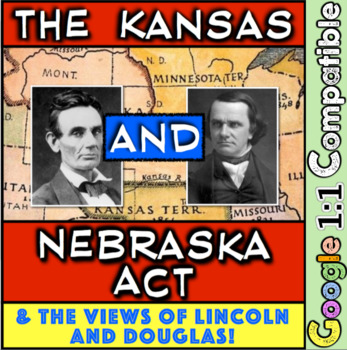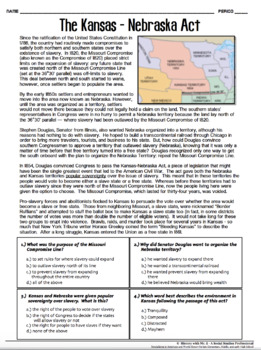Kansas and Nebraska Act & the beginnings of Lincoln Douglas Debates! Engaging!
- Zip
- Google Apps™

What educators are saying
Description
Kansas and Nebraska Act & the beginnings of Lincoln Douglas Debates! Engaging!
This resource on the Kansas and Nebraska Act is also included in the much larger Sectionalism and Irreconcilable Period Bundle, located here:
Buy the Bundle and Save a Bundle!
----------
In this highly engaging resource, students are introduced to the Kansas-Nebraska Act, the role of Stephen Douglas, the view of both the North and South, the idea of popular sovereignty, and the beginnings of the famous Lincoln-Douglas debates!
Students complete an introductory reading on the Kansas and Nebraska Act that can serve as an all-inclusive resource if time is limited! Then, students analyze two speeches (one from Abraham Lincoln and one from Stephen Douglas) to learn the differing views of slavery from Lincoln and Douglas. Finally, students complete a four step graphic organizer to understand their views!
This resource includes a paper in-class version and a 1:1 Google compatible version to be used in conjunction with Google Classroom. Just follow the included instructions for how to access the Google version, then share the resource through Google or assign via Google Classroom. This will allow students to type directly into the document!
A key is included!
----
Be sure to follow the History with Mr E Facebook page, and don't forget to signup for the Social Studies Newsletter to receive information on flash sales, product releases, and classroom tips!
----
Be sure to check out my other resources concerning sectionalism and the march toward Civil War:
The Sumner Caning: One Step Closer to Civil War! Engaging & Interactive!
The Webster-Hayne Senate Debate! Students analyze the Beginnings of Civil War!
Kansas and Nebraska Act & the beginnings of Lincoln Douglas Debates! Engaging!
Lecompton Constitution: Students analyze the debate over Kansas! Civil War!
John Brown: Hero or Criminal? Investigate John Brown's Legacy! Civil War!
Dred Scott Decision! The Argument, Ruling, Reaction, & Civil War! Common Core!
Sectionalism and The Irreconcilable Period Quiz! Buildup to Civil War! 1850s!
Nat Turner's Rebellion! A Student Webquest: Should Turner Be Remembered?





